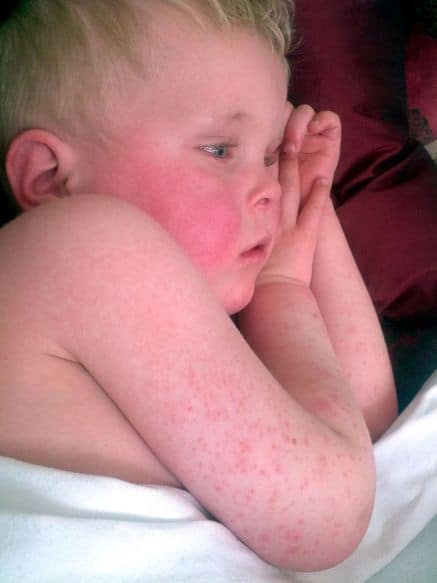Everything You Need to Know About Scarlet Fever and Slapped Cheek Syndrome
Hey there, amazing parents! Are you worried about some red rash or flushed cheeks your little one is sporting? It could be Scarlet Fever or Slapped Cheek Syndrome! Fear not, because you’re about to become the expert your kiddo needs. Read on as we unravel the mysteries of these childhood illnesses, and rest assured, with proper care, your child will be back to their playful self in no time!
What is Scarlet Fever?
Scarlet Fever, also known as scarlatina, is a bacterial infection that can develop in children who have strep throat. It is characterized by a bright red rash that feels like sandpaper to the touch and is usually accompanied by a high fever and a sore throat.
Signs and Symptoms of Scarlet Fever
- Flushed Face: Your child might have a flushed face with a pale ring around their mouth. That’s a classic sign!
- Red Rash: This rash starts on the chest and tummy and can quickly spread over the body, making it look like a sunburn with bumps.
- Fever and Chills: A fever over 101°F (38°C) with chills is often one of the first signals of the infection.
- Sore Throat: A severe sore throat can be an early indicator.
- Strawberry Tongue: The tongue may look red and bumpy, like a strawberry. Yikes, but it’s a big clue!
What is Slapped Cheek Syndrome?
Slapped Cheek Syndrome, or Fifth disease, is caused by parvovirus B19. Unlike Scarlet Fever, this viral infection is known for its distinctive bright red rash on the cheeks. It’s most common in children, but it’s no boogie monster; let’s learn why!
Signs and Symptoms of Slapped Cheek Syndrome
- Bright Red Cheeks: The hallmark “slapped” cheeks appearance is hard to miss.
- Mild Fever: Some children may experience a low-grade fever.
- General Upset: Kids might feel a bit under the weather with symptoms like a runny or stuffy nose.
- Lacy Rash: After a few days, a lacy-patterned rash may appear on the body and limbs which could be itchy.
Treatment and Care at Home
Both Scarlet Fever and Slapped Cheek Syndrome are usually mild and can be treated at home. But they’re different beasts when it comes to what’s causing them and how they should be handled. Here are some super-parent tips for nursing your child back to health for each condition:
Managing Scarlet Fever
- Antibiotics: Since it’s a bacterial infection, your child will need antibiotics prescribed by a doctor. Super important!
- Rest is Best: Make sure your little one gets plenty of sleep to help their body fight the infection.
- Hydration Station: Offer lots of fluids to keep them hydrated and to soothe that sore throat.
- Pain Relief: Over-the-counter pain relievers like acetaminophen can help with the fever and the sore throat.
Unlike Scarlet Fever, Slapped Cheek Syndrome is caused by a virus, so antibiotics won’t help here. The body clears the virus on its own, but here’s how you can support your child through it:
Managing Slapped Cheek Syndrome
- Comfort and Care: Just like with a cold, rest and plenty of fluids can go a long way.
- Itch Relief: For that itchy rash, a soothing lotion or antihistamine can bring some comfort.
Being clued up on these signs, symptoms, and treatments is key to not only caring for your child but minimizing the spread of these infections. Keep following along as we delve deeper into preventive measures and what to do if complications arise. Your child’s health and well-being are the top priority, and knowledge is your best tool.
Remember, parents, you’re doing a great job! Keep smiling, stay equipped with information, and together let’s ensure our children bounce back to their healthy, happy selves. Stay tuned for more insightful and comforting guidance on how to navigate the road to recovery from Scarlet Fever and Slapped Cheek Syndrome.

Five Things Parents Should Know in Preparing for Scarlet Fever or Slapped Cheek
1. Recognize the Early Signs
Early detection can be a game-changer. For Scarlet Fever, look out for that tell-tale sandpaper-like rash, fever, and sore throat. Slapped Cheek Syndrome, on the other hand, presents with those distinct red cheeks. Being observant means you can take action swiftly!
2. Preventing Spread is Super Important!
These conditions can be contagious. While Scarlet Fever is bacterial and generally spread through droplets (think coughing and sneezing), Slapped Cheek Syndrome can also pass from person to person, especially before symptoms like the rash appear. Teach your kids to practice good hygiene—washing hands is a superhero skill!
3. Understanding When to Seek Medical Advice
If you suspect Scarlet Fever, consult your healthcare provider for an accurate diagnosis and prescription antibiotics. With Slapped Cheek Syndrome, medical advice is often not needed unless symptoms worsen or you have concerns, especially in children with weakened immune systems.
4. Comfort is Key
Illness isn’t fun, but your care can ease the journey. Keep your child’s room comfortably cool, dress them in loose clothing, and soothe them with cuddles. Even a calm environment can promote healing and reduce any anxiety they may feel about being unwell.
5. Keep Nutrition in Check
When kids are sick, they might not have much of an appetite. It’s vital, though, to maintain nourishment. Offer easy-to-swallow, nutritious foods and encourage them to drink. Smoothies, soups, and broths can be both hydrating and comforting.
Preventive Measures and Tips
Staying one step ahead includes taking preventive measures against these illnesses:
- Emphasize personal hygiene to your children, such as regular hand-washing and using tissues.
- Keep your child home if they’re not feeling well to reduce the spread to others.
- Ensure their vaccinations are up to date to bolster their defense against infections.
- Maintain a clean home environment, disinfecting surfaces regularly.
What to Do If Complications Arise
While most cases are mild, some children may develop complications, especially from Scarlet Fever if not treated properly with antibiotics. Keep an eye out for any signs of worsening symptoms, such as a persistent high fever, difficulty breathing, or significant fatigue. If these concerns crop up, reaching out to your child’s healthcare provider is crucial.
For Slapped Cheek Syndrome, complications are rare but can include joint pain or swelling, which usually resolves on its own. However, if your child has an underlying health condition like sickle cell disease or a weakened immune system, you should contact your healthcare provider as complications can be more severe.
There you have it, friends! Armed with this knowledge and a sprinkle of parental instinct, you’re well on your way to managing these rashes like a pro. Keep these tips handy, and remember to add a dash of love to all your care—it’s the magic ingredient that makes all the difference! Let’s help those kiddos get the bounce back in their step and the joy back in their play. Keep it up, incredible parents!
See more great Things to Do with Kids in New Zealand here. For more information see here
Disclaimer
The articles available via our website provide general information only and we strongly urge readers to exercise caution and conduct their own thorough research and fact-checking. The information presented should not be taken as absolute truth, and, to the maximum extent permitted by law, we will not be held liable for any inaccuracies or errors in the content. It is essential for individuals to independently verify and validate the information before making any decisions or taking any actions based on the articles.




